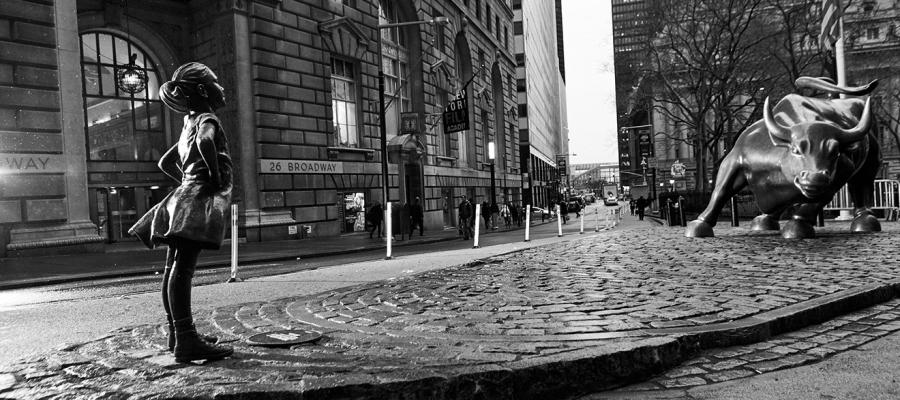
Have you ever seen a beautiful television spot, only to have it ruined by learning it’s an advertisement? Have you ever been delighted by a musical performance, only to learn the singers were lip-synching? Have you ever seen a heart-melting painting and then found out it’s fake?
Such experiences are common but strange. Like jilted lovers, we feel played. Something about the origins or intentions behind the pieces ruins them.
But is that the right response? From another perspective, it seems rational to say, “Well, I suppose rapacious oil companies can make beautiful advertisements after all.” Or, “It’s still a great song!” Or, “Gee, the copy really is as good as the original.”
My occasion for raising this puzzle is the heated discussion surrounding the famous/infamous Fearless Girl statue, which appeared in the New York Financial District on March 7 of this year, a day before International Women’s Day.
At first sight, Fearless Girl, standing across from Wall Street’s iconic Charging Bull, is a powerful symbol of opposition to patriarchal values, which are at their worst in the male-dominated world of high finance. But if you look to her origins, you might experience an astonishing flip of perspective.
While acknowledging the raw visual power of Fearless Girl (especially in context), we should confront a few facts. First, Fearless Girl was commissioned by a large financial powerhouse, State Street Global Advisors (SSgA), as a way of marketing a stock index; the advertisement campaign she’s a part of was developed by the advertising giant McCann. That index, to be fair, aggregates companies that do more for gender equity, and its ticker is SHE. But many people’s admiration of Fearless Girl dwindles on finding out she owes her existence to the intention to sell a stock index. Second, Charging Bull was never corporate art in the first place. Arturo Di Modica, a Sicilian immigrant, created it at his own expense after the stock market crash of 1987, in order to celebrate the dynamism of these United States. Those in charge of the New York Stock Exchange didn’t even like it at first and initially had it removed.
So now you may have that feeling again, like you just got played. The best artistic icon of gender equity in years is hawking stock. Fearless Girl is still a solid work of art—and congratulations to Kristen Visbal for creating her—but SHE seems not as fantastic as we thought.
Two questions now arise, given all that’s been said; one is descriptive and the other normative.
Descriptively: what is the psychology of liking or loathing artwork because of its origins?
Normatively: is it right, rational, or reasonable to be so affected by the origins of a work?
The most compelling work in psychology I know of concerning the descriptive question comes from Paul Bloom’s lab at Yale. In discussing why authentic paintings are valued above convincing forgeries, George Newman and Bloom suggest two mechanisms. First, there is a performance aspect: the way a work is created is seen as a performance in its own right, and that performance can be better or worse (with mere copying being unimpressive). Second, the psychological mechanisms of contagion seem to be at play. Human contagion detection evolved to keep us away from harmful, body-polluting substances. But those mechanisms easily transfer to other domains and easily attach to objects associated with iniquitous actions. Would you buy a stolen laptop at a good price? If not, that might be because your contagion system marks that laptop as tainted. Similarly, a piece of art might seem tainted, if it was created with deceptive intent.
I think both mechanisms are involved in people’s reappraisal of Fearless Girl. When I first saw the image of her facing the Bull, I imagined a lone artist working in secret and then courageously placing her work opposite the Bull in the middle of the night. Frankly, though Fearless Girl is still a powerful piece, the performance of creating her is not as impressive, now that I know she was backed by a financial powerhouse. But the contagion aspect may be even more fundamental. Fearless Girl seems tainted—by corporate feminism, some say. She’s bespotted in people’s minds by the dirty and deceptive corporate intentions that went into creating her.
To turn to the normative question, are we right to respond as we do to origins and intentions? I think the psychology just reviewed puts us in a better position to address this question.
My view is that it makes sense to value the performance involved in creating a work. Creation can be beautiful and dramatic, often involving a story with fascinating details, full of risk, disappointment, and reward. Di Modica spent $360,000 of his own money and two years of his life creating Charging Bull, only to have it initially rejected by NYSE—then recalled to life by a loving public. That story is enshrined in the bronze itself, and we’re right to value it. The creation of Fearless Girl—contrary to what most people thought—is, ironically, less inspiring, so the performance component of our valuing drops.
But I think we may be led astray by our psychological mechanisms of contagion. There is a raw visual power in the juxtaposition of the little girl and the bull that we shouldn’t lose sight of, regardless of how annoyed we are at financial greed that fueled her origins. If we rejected all art with tainted origins, we’d miss some of the best material. Much art owes its existence to the support of wealthy benefactors, many of whom have been ethically challenged in some way (aren’t we all?).
So in the end, I think we should still appreciate Fearless Girl for what she is, despite her less than spectacular origins. And in two hundred years, if she’s still around, I think people will still love what she stands for in the imagination, regardless of the corporate plaque at her feet.